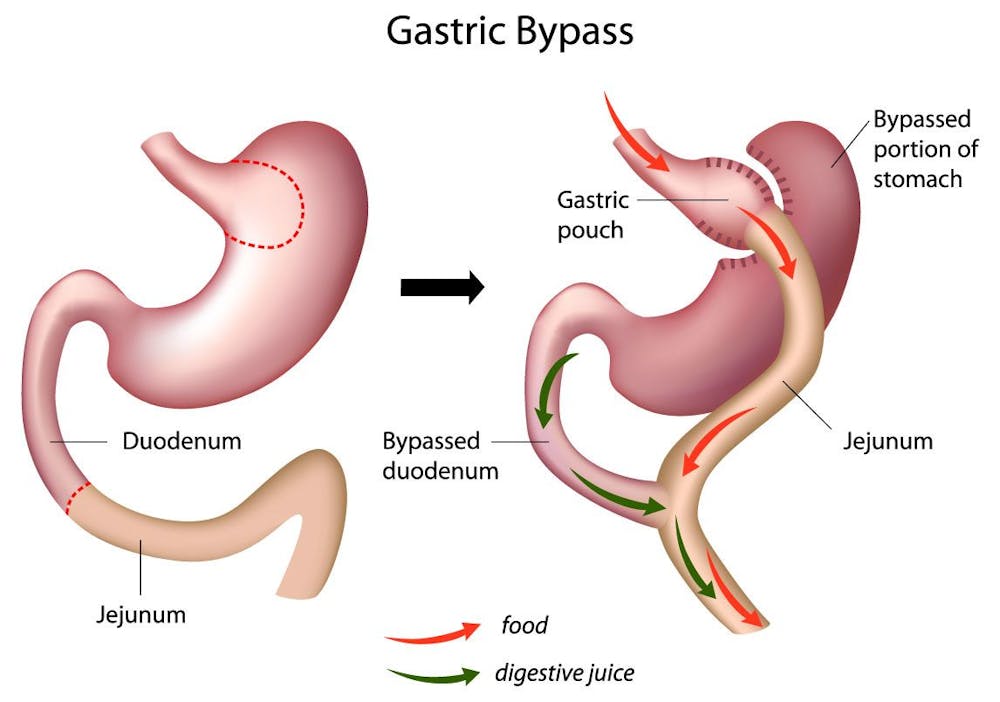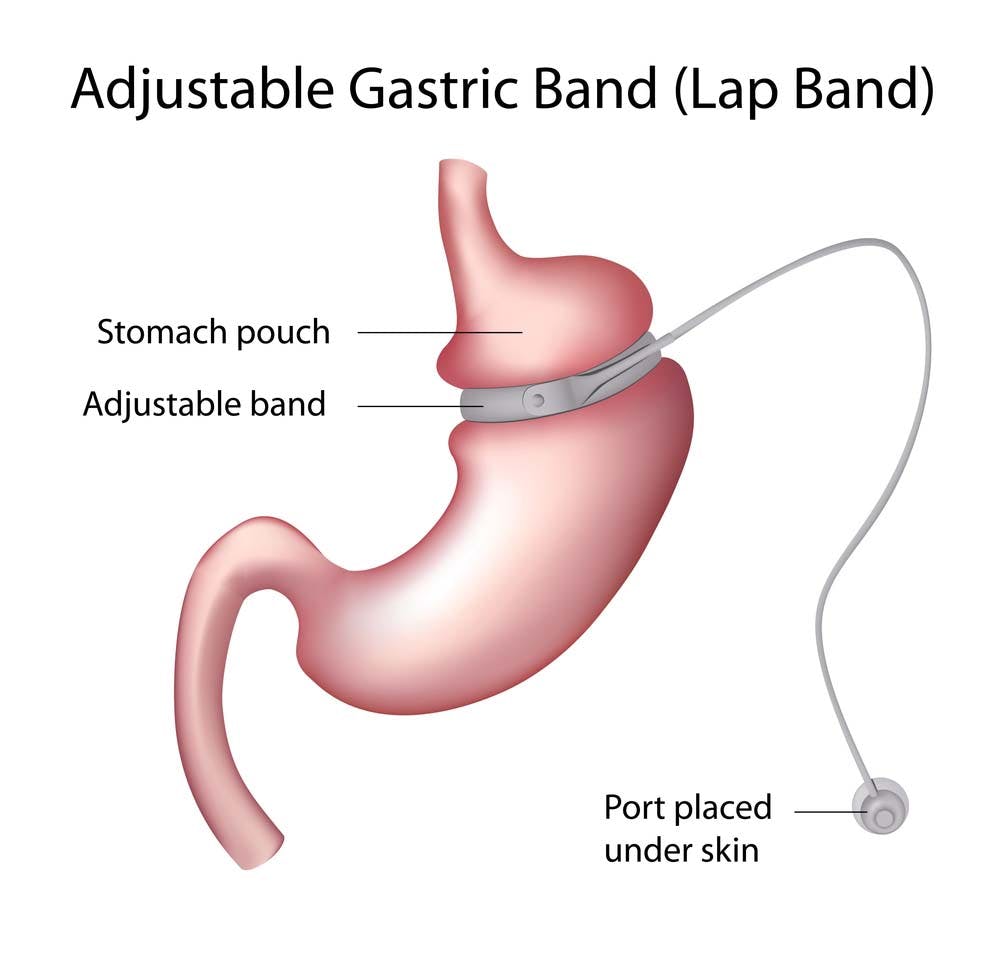Roux-en-Y gastric bypass is commonly called the "gold standard" of weight loss surgery. So many patients have achieved success with RNY bypass that it is no wonder that bariatric surgeons worldwide have performed this metabolic and bariatric surgery more than any other.
Patients may seek gastric bypass when diet and exercise to lose weight have repeatedly failed, and they have serious health issues related to obesity. The simplest gastric bypass definition is that it is a surgery that helps you lose weight by changing the way your stomach and intestines handle the food you eat.
You'll learn what does gastric bypass surgery do and how it affects losing weight.
What is Gastric Bypass Surgery?
Gastric bypass weight loss surgery, also called RYGB surgery, is a weight-loss surgery where a surgeon removes part of the stomach to create a small pouch. This reduced-size stomach connects directly to the small intestine.
The reduced stomach can only hold minimal food, making patients feel full quickly. The surgeon divides your small intestine to create the actual bypass component for the second part of the gastric bypass procedure.
The intestinal rerouting causes the food you eat to bypass a large portion of the small intestine so that your body absorbs less of the calories you consume. Thus, the smaller stomach and the rerouted intestines make RNY bypass both restrictive and malabsorptive so patients can steadily lose weight.
The RYGB medical abbreviation is another way to indicate gastric bypass surgery.
Laparoscopic Gastric Bypass (Roux-en-Y) Surgery: Key Points
The RYGB procedure has two key components: reduction in stomach size and rerouting of the small intestine. Both elements are necessary to lose the excess weight that many patients with morbid obesity must accomplish to improve their health. Most are done laparoscopically, which results in a shorter hospital stay, less pain, and a reduced risk of developing a hernia or other complications.
Part one of RYGB surgery makes the stomach smaller. The surgeon divides the stomach into two parts. Food goes into a small pouch in the upper part. The larger, lower portion of the stomach is sectioned off with staples. As the pouch only holds about one ounce of food, patients will eat less and lose weight.
In the second part of this procedure, the surgeon divides the small intestine into several parts. First, the surgeon connects a short length of the small intestine to a small hole in the newly-created pouch.
This step is the actual bypass as the food you eat skips the duodenum, the first part of the small intestine where the body absorbs the most calories. The top portion of the divided small intestine is then connected further down so that stomach acids and digestive enzymes from the stomach's bypassed area can mix with food.
Gastric bypass is the gold standard of weight loss surgery because of these key points:
- The most extensively studied bariatric procedure
- Considered the most effective weight loss surgery with balances of risks and benefits
- Helps reduce the perception of hunger
- Significantly reduces stomach size and skips about four feet of intestine to allow you to absorb less fat
- Effective in treating heartburn or acid reflux
- Average loss of about 75% of excess weight
- Extremely effective at curing type 2 diabetes through hormonal changes
RNY (Roux-en-Y / Roo-en-Wy) Meaning
The surgical connection, called the anastomosis, looks like the letter Y. Some people also say that "in the form of Y" is also an RNY meaning.
What Happens During Gastric Bypass Surgery
Before surgery, you will receive general anesthesia to keep you comfortable during the procedure. The specifics of RNY bypass depend on your situation and your surgeon's preferences, but usually, this bariatric surgery to make the stomach smaller is conducted in one of two ways: laparoscopically or as an open procedure. Laparoscopic means the surgeon will make several small incisions in the abdomen to insert the instruments and the camera to guide the process.
Only a small percentage of RGBY procedures are performed with traditional large (open) incisions, usually when the surgeon sees a complication.
First, the surgeon cuts your stomach, sealing the top part off from the rest. The resulting stomach pouch is about the size of a walnut and holds about an ounce of food. A normal stomach holds about three pints of food.
Next, the surgeon cuts the small intestine into several pieces and sews one part directly into the pouch. Food will travel from the new part of the stomach into the new bowel segment, which is connected about three to four feet in the middle of the small intestine. The resulting roux-en-y gastric bypass anatomy resembles the letter Y.
The surgery usually takes two to four hours. Afterward, you'll go to a recovery room to awaken and have the medical staff monitor you for complications.
Roux-en-Y Gastric Bypass Anatomy
 This graphic shows the gastric bypass anatomy and how the surgeon resections the small intestine.
This graphic shows the gastric bypass anatomy and how the surgeon resections the small intestine.
The roux limb is a section of the intestine attached to the new stomach pouch. Food flows directly from the new part of the stomach into the Roux limb and then mixes with the biliopancreatic limb.
This latter portion contains digestive juices from the stomach, gallbladder, and pancreas.
Gastric Bypass Surgery Results
 The gastric bypass works in several ways. Like many bariatric procedures, the newly created stomach pouch is smaller and holds less food, which means fewer calories are ingested.
The gastric bypass works in several ways. Like many bariatric procedures, the newly created stomach pouch is smaller and holds less food, which means fewer calories are ingested.
Additionally, the food does not come into contact with the first portion of the small bowel, resulting in decreased absorption. Most importantly, the modification of the food course through the gastrointestinal tract has a profound effect on reducing hunger, increasing fullness, and allowing the body to reach and maintain a healthy weight.
The impact on hormones and metabolic health often improves adult-onset diabetes even before any weight loss occurs. The operation also helps patients with reflux (heartburn), and often the symptoms quickly improve.
Along with making appropriate food choices, patients must avoid tobacco products and non-steroidal anti-inflammatory drugs (NSAIDs) such as ibuprofen and naproxen.
How Dangerous is Gastric Bypass Surgery?
As with any major surgery, patients ask, "Is gastric bypass surgery dangerous? Gastric bypass and other weight-loss surgeries pose potential health risks, both short- and long-term. About 1% to 5% of patients have life-threatening or serious complications like:
- Blood clots
- Heart attack
- Leaks in the surgical connections with the small intestine
- Serious infection or bleeding
The complication rate is lower at hospitals that perform over 100 weight loss surgeries each year.
Deaths are rare, usually less than one in 200, especially when a high-qualified surgeon performs the procedure.
Short- and Long-Term Risks
Risks associated with the surgical procedure are similar to any abdominal surgery and can include:
- Adverse reactions to anesthesia
- Lung or breathing problems
- Injury to the stomach, intestines, or other organs
Longer-term risks and side effects of gastric bypass can include:
- Scarring that can lead to bowel obstruction
- Dumping syndrome, causing diarrhea, nausea, or vomiting
- Gallstones
- Hernias
- Low blood sugar
- Malnutrition requiring vitamin and mineral supplements
- Stomach perforation
- Ulcers, heartburn, or gastritis
- Vomiting when you eat more than your new stomach can hold
- Leaks from the stomach staples
What is the Success Rate of Gastric Bypass Surgery?
Gastric bypass patients achieve excellent short-term weight loss of about 60 to 80% of excess weight.
The results are long-lasting, too, as studies show that most patients maintain weight loss of more than 50% 20 years after surgery. Results depend on exercise and eating habits. Most people lose about 20 pounds a month for the first year after surgery. Weight loss decreases during the second year.
Besides weight loss, gastric bypass surgery results include improving the following conditions related to morbid obesity:
- Gastroesophageal reflux disease (GERD)
- Heart disease
- High blood pressure
- High cholesterol
- Obstructive sleep apnea
- Type 2 diabetes
- Stroke
- Infertility
- Asthma
Gastric bypass can also improve your ability to perform routine activities, thus improving your quality of life.
Roux-en-Y Gastric Bypass (RYGB) Recovery Time
Typically, patients stay in the hospital two to four days following surgery. You may have a catheter in your nose leading into the stomach to help drain fluids for a day or two. Patients can also expect to wear special stockings to prevent blood clots in the legs. While in the hospital, you will start on a liquid diet and will be released when you can keep the liquids down without vomiting.
Most people take two to four weeks off from their jobs, depending on the type of work they do. You may return to normal activities within three to five weeks. After six weeks, you can begin a light workout regimen to help boost weight loss.
During The first five to six post-op weeks, your diet will progress from liquids to pureed foot, then to soft foods, and finally a normal diet with smaller portions. The post-surgery period helps your stomach heal and allows you to get used to new, healthier eating habits.
What Kind of Doctor Does Gastric Bypass Surgery?
Gastroenterologists, doctors specializing in the human digestive system, perform roux en y gastric bypass and other weight-loss surgeries.
They are specialists known as bariatric surgeons.
Laparoscopic Gastric Bypass Surgery Alternatives
Common alternatives to gastric bypass surgery are:
- Sleeve gastrectomy.
- Duodenal switch weight loss surgery.
- Gastric band.
- A newer procedure called gastric balloon placed into your stomach via an endoscope.
Roux-en-y gastric bypass vs. sleeve gastrectomy generally produces better weight loss results.
What is a Gastric Band?
 An inflatable gastric band, commonly called a Lap-Band, is a silicone device placed around the top portion of the stomach to treat severe obesity.
An inflatable gastric band, commonly called a Lap-Band, is a silicone device placed around the top portion of the stomach to treat severe obesity.
As a restrictive device, it makes patients feel fuller faster.
Gastric band is the least invasive bariatric, and it sometimes is considered an alternative to roux-en-y gastric bypass.
Patients generally lose fewer pounds with this weight loss surgery.
Candidates for Gastric Bypass Procedure
Generally, good candidates for gastric bypass surgery have severe obesity with a BMI of 40 or higher or a BMI of at least 35 with serious weight-related health problems, like type 2 diabetes, high blood pressure, or severe sleep apnea.
Some patients may also qualify with a BMI of 30 or more if their health problems are severe. You will also need to be in good general health and go through extensive screening to qualify.
Remember that gastric bypass is not a quick fix but is a lifestyle change that will significantly change your life. Contact us today to find out if Roux-en-Y surgery is the right one for you.

